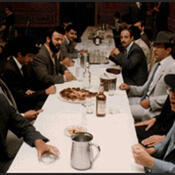 The ultra-Orthodox Hasidic communities in America often live in close proximity, retaining a strong sense of identity distinct from secular American culture. A tish is an Orthodox Hasidic practice in which a ritual meal is shared between men in a Hasidic community and their rebbe, the Hasidims’ spiritual leader, after which the rebbe lectures on Jewish scriptures, the Torah and Talmud.
The ultra-Orthodox Hasidic communities in America often live in close proximity, retaining a strong sense of identity distinct from secular American culture. A tish is an Orthodox Hasidic practice in which a ritual meal is shared between men in a Hasidic community and their rebbe, the Hasidims’ spiritual leader, after which the rebbe lectures on Jewish scriptures, the Torah and Talmud.
The ultra-Orthodox Hasidic Jewish community has maintained traditions distinctive of old-world European Judaism. Ravaged by the Holocaust, the remnants of the numerous Hasidic communities of Eastern Europe came to America in the years following World War II and began to thrive, establishing communal footholds in the New York City area: in Brooklyn’s Williamsburg, Borough Park, and Crown Heights, and in the suburban enclaves of Monsey, New Square and Lakewood.
Although they became residents in America, the Hasidic community has long preferred to preserve a strong sense of identity quite distinct from a secular and pluralistic society. Their self-segregation is reflected, for example, in their characteristic dress, which has preserved the costume of 18th century Polish noblemen. While they have little to do socially with the majority of American Jews, they have much in common religiously, performing the same rituals, reading the same texts, and celebrating the same holidays.
One custom unique to the Hasidim is the tish, which centers on the spiritual leader of the Hasidim, the rebbe. The rebbe is the metaphorical shepherd of his flock, and his Hasidim look to him for guidance and inspiration in every aspect of life. In order to have contact with their rebbe on a more frequent basis, the Hasidim developed the practice of the tish. A tish, the Yiddish word for “table,”—that is, the rebbe’s table—is the periodic occasion when the entire male Hasidic community is invited to share a meal with the rebbe. The attendees, invited like privileged guests, gather in a large hall, sit around long tables, crowding into every available space. At the front sits the rebbe, surrounded by other Hasidic leaders. On Jewish holidays or on the Sabbath, he makes blessings first over the wine and then over the braided bread called challah or, according to the most traditional customs, over twelve loaves. The tish consists of a full meal in which the rebbe partakes and in which all his Hasidim symbolically share. After he eats, he passes out the leftovers, or shirayim, so that all may be connected with the rebbe’s every action. The Lubavitch Chabad, known informally as the Lubavitchers, are one sect of the Hasidim that does not practice the custom of shirayim and prefers to call the tish a fabrengen (gathering).
After the meal, the rebbe begins his talk, which is generally an extended discourse on the Torah or Hasidic lore, including folktales and intricate exegetical interpretations. Periodically, at the conclusion of especially salient points, the entire assembly will shout, “ah-men!” and down a cup of the vodka or schnapps set in front of them. A rousing Hasidic hymn will follow, often to the tune of an old Russian or Polish drinking song. At a later point in the evening, the assembly will rise and begin dancing in a line around the room, sometimes joined by the rebbe as they circle. Singing and dancing may go on all night as the Hasidim reach a point of mystical religious experience marked by ecstasy and exhaustion. With the rebbe, the tish is characteristic of the Hasidic approach to God through untrammeled mystical encounter.